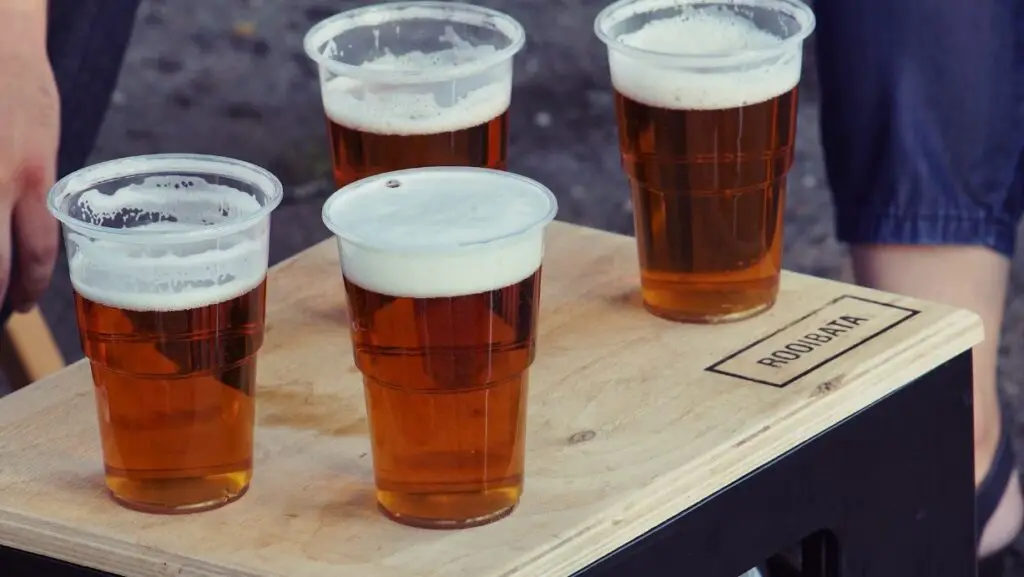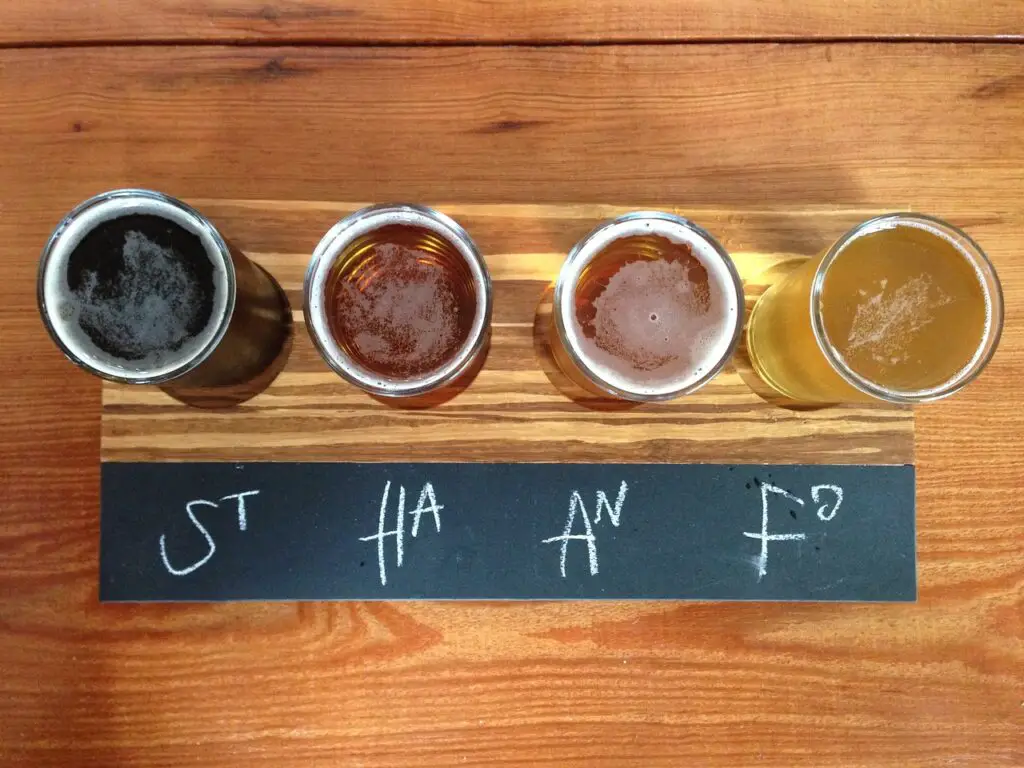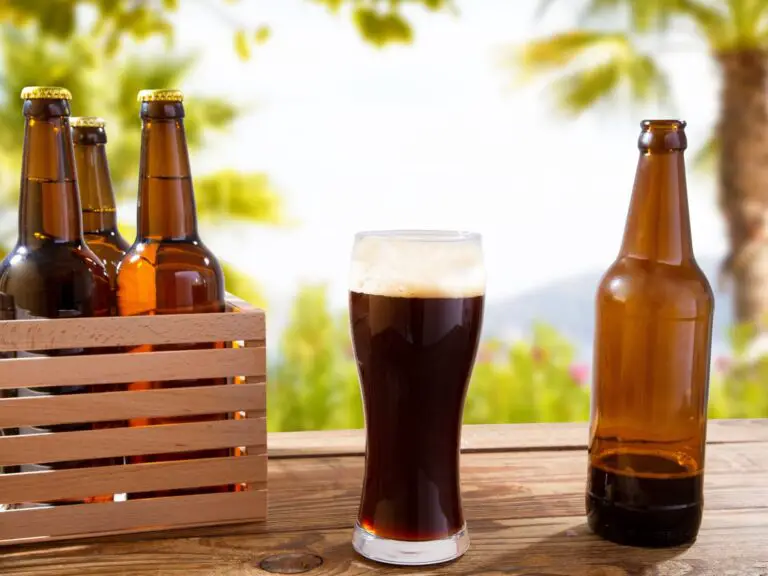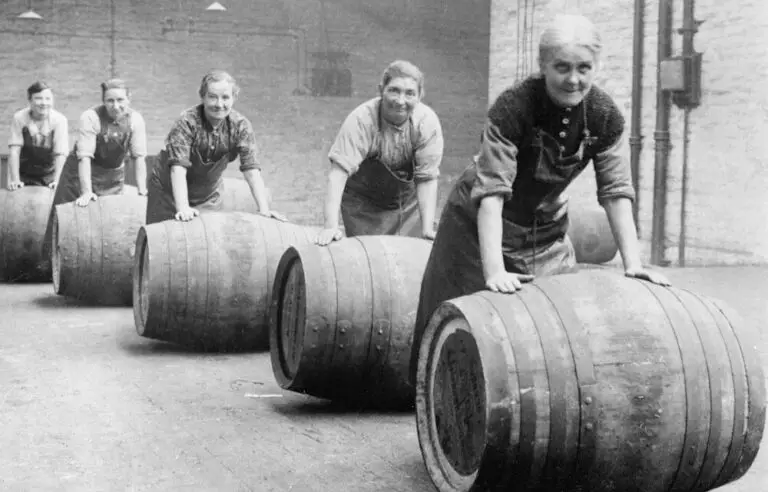Does Beer Have Tannins?
Does beer have tannins? Let’s see…
YES, beer can contain tannins, but the levels vary depending on the brewing process and ingredients used. Tannins are often present in the grains and hops used in brewing, contributing to the beer’s flavor and mouthfeel.
Follow us on Instagram!
While not as prominent as in wine, some beer styles showcase noticeable tannin characteristics.

How Much Tannins Are In Beer?
The tannin content in beer can vary depending on factors like ingredients, brewing methods, and aging. Generally, beer tends to have lower tannin levels compared to wine. Here are approximate ranges for some common beer styles:
- Light Lagers (like Duff beer): 20 to 50 mg/L
- Pale Ales: 30 – 70 mg/L
- IPAs (India Pale Ales): 40 – 80 mg/L
- Stouts and Porters: 50 – 100 mg/L
- Barleywines: 80 – 150 mg/L
Keep in mind that these are general estimates, and actual tannin levels can vary between individual beers within each style. The brewing process and the specific ingredients chosen by brewers play a significant role in determining the final tannin content.
How Much Tannins Are in Wine?
The tannin content in wine varies based on several factors, including the grape variety, winemaking techniques, and aging process. Red wines generally have higher tannin levels than white wines because tannins are primarily extracted from the grape skins, seeds, and stems during the fermentation of red grape juice with their skins.
The tannin concentration is often measured in milligrams per liter (mg/L) or parts per million (ppm). As a general guideline, here it is:
Red Wines
- Light-bodied red wines: 50-100 mg/L
- Medium-bodied red wines: 100-200 mg/L
- Full-bodied red wines: 200+ mg/L
White Wines
- White wines typically have lower tannin levels than red wines.
- Tannin levels in white wines can vary widely but are generally below 50 mg/L.

What Are Tannins?
Tannins are naturally occurring compounds found in various plants, including grapes, tea leaves, and certain grains. They belong to a class of polyphenolic compounds and are known for their astringent taste and ability to bind to proteins. In plants, tannins often serve a protective function, deterring herbivores and preventing microbial infections.
In the context of beverages like wine and beer, tannins are derived from the skins, seeds, and stems of grapes in winemaking, and from grains and hops in brewing. The importance of tannins lies in their impact on flavor, mouthfeel, and color. They contribute to the astringency in beverages, creating a drying sensation in the mouth.
While tannins are generally safe for consumption and are responsible for the complexity and structure of many beverages, excessive levels can lead to an overly astringent or bitter taste, potentially affecting the overall enjoyment of the drink. However, moderate levels of tannins are often desirable, contributing to the balance and character of the beverage. It’s essential to strike a proper balance in brewing and winemaking to achieve a harmonious and enjoyable taste profile.

Tannins in Beer
Tannins in beer are derived from the grains and hops used during the brewing process. While not as prominent as in wine, tannins contribute to the overall flavor, mouthfeel, and complexity of beer.
Here’s a brief overview:
1. Formation of Tannins
- Tannins in beer primarily come from the skins and seeds of grains like barley and from the hops. During the mashing and lautering stages of brewing, tannins can be extracted from the grain husks.
- Tannin extraction is influenced by factors such as temperature, pH levels, and the duration of the brewing process. Improper handling of these factors can lead to the over-extraction of tannins, resulting in an astringent taste.
2. Grains and Tannins
- Malted barley, a key ingredient in beer, contains tannins in its husk. The level of tannins varies among different malted barley varieties.
- The mashing process, where the grains are soaked in hot water to extract fermentable sugars, also allows for the extraction of tannins from the grain husks.
3. Hops and Tannins
- Hops contribute bitterness and aroma to beer, and certain hop varieties also contain tannins.
- Tannins from hops can add to the perceived bitterness in beer, complementing the bitterness derived from hops’ alpha acids.
4. Natural Presence of Tannins in Beer
- Yes, tannins are naturally present in beer, but their levels can be influenced by the brewing process and the specific ingredients used.
- Some beer styles, such as certain ales and stouts, may showcase more noticeable tannin characteristics, contributing to the beer’s body and mouthfeel.
Brewers often aim for a balanced extraction of tannins to enhance the beer’s structure without introducing an unpleasant astringency. Careful control of brewing parameters, including mash temperature and duration, can help achieve the desired tannin levels in the final beer product.

Tannins and Hop Types
The impact of hop varieties on tannin levels in beer is a nuanced aspect of brewing that contributes to the overall flavor profile, bitterness, and mouthfeel of the final product.
Here’s a closer look at how different hop varieties influence tannin levels:
1. Tannins in Hops
- While hops are traditionally known for contributing bitterness, flavor, and aroma to beer through compounds like alpha acids and essential oils, some hop varieties also contain tannins.
- Tannins extracted from hops can contribute to the overall astringency of the beer, adding a drying and puckering sensation to the mouthfeel.
2. Bitterness and Tannins
- The bitterness in beer is primarily attributed to alpha acids in hops, but tannins also play a role in perceived bitterness.
- Tannins contribute a different type of bitterness compared to alpha acids, often described as a more lingering and mouth-drying bitterness.
3. Hop Selection and Brewing Techniques
- Brewer’s choice of hop varieties and the quantities used can significantly influence the tannin content in beer.
- Some hop varieties are known for higher tannin levels, and brewers may intentionally select or avoid certain hops based on the desired beer style and flavor profile.
- The brewing process, including the timing of hop additions during boiling and dry hopping, can also impact the extraction of tannins.
4. Beer Styles and Tannin Variations
- Different beer styles may showcase varying levels of tannins, influenced by the choice of hop varieties and brewing techniques.
- For example, hoppy beer styles like India Pale Ales (IPAs) may have a more noticeable tannin presence due to the higher hop content.
5. The Balancing Act
- Brewers aim to strike a balance between the bitterness contributed by alpha acids and the astringency introduced by tannins.
- Careful hop selection and meticulous brewing practices allow brewers to control the overall sensory experience, ensuring that the beer’s bitterness and mouthfeel align with the intended style.

Tannins and Different Beer Styles
A. Variations in Tannin Levels Across Different Beer Styles:
Lighter beer styles – Lighter beer styles, such as lagers and pilsners, generally have lower tannin levels. The focus in these styles is often on crispness and a clean finish, with minimal astringency
Ales – Many ale styles, including pale ales and amber ales, may exhibit moderate tannin levels. The malt bill and hop choices in ales contribute to the overall tannin profile.
B. Influence of Tannins on the Flavor Profile of Beers:
Body and mouthfeel – Tannins contribute to the body and mouthfeel of beer. Beers with higher tannin levels can have a fuller and more robust mouthfeel, often described as having depth and structure.
Astringency – Tannins, when present in excess, can lead to astringency, imparting a dry and puckering sensation in the mouth. Brewers aim to balance tannin levels to avoid unpleasant astringency.
C. Popular Beer Styles Known for Tannin Presence:
Stouts and porters – Stout and porter styles, especially those with roasted malts and a significant malt presence, can exhibit noticeable tannins. The tannins contribute to the complexity and richness of these dark beers.
Barleywines – Barleywines, known for their high alcohol content and rich malt character, may have elevated tannin levels. Tannins complement the sweet and malty flavors in these strong ales.
IPAs (Indian Pale Ales) – Some hop-forward beer styles, particularly certain IPAs with a substantial hop load, may showcase tannin presence. The interplay between hop tannins and hop bitterness contributes to the overall complexity.

Tannins and Astringency
A. Differentiating Between Tannins and Astringency:
Tannins
- Tannins are polyphenolic compounds found in various plant materials, including grains and hops in beer. They contribute to the flavor, mouthfeel, and complexity of the beverage.
- Tannins can impart a drying sensation in the mouth but are not necessarily unpleasant in moderate amounts.
Astringency
- Astringency is a sensory perception characterized by a dry, puckering, or mouth-drying sensation.
- While tannins contribute to astringency, not all astringency is solely due to tannins. Other factors, such as excessive hop bitterness or certain brewing processes, can also contribute to astringency.
B. Understanding the Sensory Aspects of Astringency in Beer:
Mouthfeel
- Astringency in beer is often associated with a rough or coarse mouthfeel, creating a sensation of dryness on the palate.
- The intensity of astringency can vary, ranging from subtle to pronounced, impacting the overall drinking experience.
Causes of Astringency
- In addition to tannins, astringency in beer can result from over-extraction of compounds during brewing, such as polyphenols from grains or excessive hop bitterness.
- Inadequate rinsing of brewing equipment or the use of contaminated water can also introduce unwanted astringency.
C. Relationship Between Tannins and Perceived Bitterness:
- Tannins contribute a different form of bitterness compared to hop bitterness. While both can be perceived as bitter, tannin-induced bitterness often exhibits a more lingering and mouth-drying character.
- The relationship between tannins and perceived bitterness is complex, as both factors contribute to the overall taste profile of the beer.

Beer Tasting and Tannins
A. Tips for Detecting Tannins in Beer:
Mouthfeel
- Pay attention to the mouthfeel of the beer. Tannins can contribute to a sense of astringency, resulting in a dry and puckering sensation in the mouth.
- Assess the level of fullness or thickness in the mouth, as higher tannin content can contribute to a more robust and structured feel.
Aftertaste
- Note the aftertaste or finish of the beer. Lingering bitterness, especially one that extends beyond the initial sip, may be indicative of tannins.
- Tannins can leave a lasting impression on the palate, contributing to the overall complexity of the beer.
Style awareness
Be aware of the beer style being tasted. Some styles, such as stouts and barleywines, are more likely to exhibit pronounced tannins, while lighter styles may have minimal tannin presence.

B. How Tannins Contribute to the Overall Beer Tasting Experience:
Complexity and Structure
- Tannins contribute to the complexity of beer, providing an additional layer of flavor and mouthfeel. They add depth and structure, enhancing the overall drinking experience.
- In beers with appropriate tannin levels, the interplay between other components, such as malt sweetness and hop bitterness, can create a harmonious and balanced flavor profile.
Mouthfeel and Body
- Tannins influence the mouthfeel and body of the beer. Beers with higher tannin content may have a fuller and more substantial feel on the palate.
- The tactile experience of tannins contributes to the overall texture and richness of the beer.
Flavor integration
Tannins, when well-integrated, enhance the beer’s overall flavor without overshadowing other elements. They can complement malt sweetness, hop bitterness, and other flavor components, resulting in a cohesive and enjoyable taste profile.
Astringency management
- When tannins are appropriately managed, the beer tasting experience is enhanced, avoiding the negative aspects of excessive astringency.
- Brewers carefully control tannin levels to achieve a balanced and nuanced beer that appeals to a wide range of palates.

So – Is It Tannins or Astringency?
Both tannins and astringency play important roles in the world of beer, but the key is balance. It’s not a matter of one being more important than the other; instead, it’s about achieving a harmonious and enjoyable beer-drinking experience.
Tannins:
- Contribute to the complexity and structure of beer.
- Enhance mouthfeel, body, and overall texture.
- Add depth to the flavor profile, complementing other elements in the beer.
Astringency:
- Can result from tannins and other factors, presenting as a dry, puckering sensation.
- Should be managed carefully to avoid an unpleasant and overpowering dryness.
Wrapping It Up
In conclusion, the world of beer is a delightful journey filled with diverse flavors and textures, and tannins play a subtle yet significant role in shaping this experience. As we’ve discovered, these compounds, sourced from grains and hops, contribute to the complexity, mouthfeel, and overall character of our favorite brews. From stouts to ales, understanding the interplay of tannins allows us to appreciate the nuances that make each beer unique.

I am a young architect with a passion that goes beyond blueprints… it’s beer! undertherosebrewing.com is more than just a blog, it’s a manifestation of my lifelong dream to explore, read, and learn everything about beer. Join the blog on this unfiltered and genuine adventure into the heart of beer culture. Cheers!






